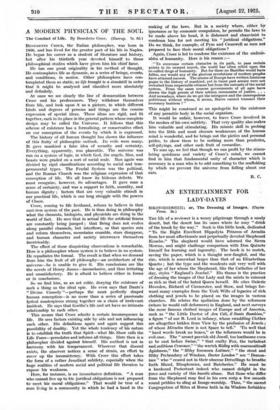AN ENTERTAINMENT FOR LADY-DAYES
THE life of a reviewer is a weary pilgrimage through a sandy desert, but the desert has its oases where he may " drink of the brook by the way." Such is this little book, dedicated " To the Right Excellent Hippolyta Princess of Arcadia from her most affectionate and perpetually devoted Shepheard Kenelm." The shepherd would have adorned the Sierra Morena, and might challenge comparison with Don Quixote himself for learning and ingenuity. The book is to match, saving the paper, which is a thought new-fangled, and the size, which is somewhat larger than that of an Elizabethan Quarto ; but the type and the woodcuts suit very well with the age of her whom the Shepheard, like the Catholics of her day, styles " England's Jezebel." His theme is the practice of dressing the images of Our Lady, and the saints in raiment as rich as that of the hated Queen herself. He cites Orderic Hoveden, Richard of Cirencester, and Stow, and brings for- ward many examples from the York Wills of legacies of rich clothing and jewels to be placed on the images in various churches. He relates the spoliation done by the reformers (whom he would call deformers) in England, and next surveys the more famous clothed images of Europe and of America, such as " the Little Doctor of Ara Celi, it Santo Bambino," a figure " of our B. Lord in infancy, whose swaddling Clothes are altogether hidden from View by the profusion of Jewels ; of whose Miracles there is not Space to tell." 'Tis well that " hard words break no bones," or the reformers would be in evil case. The " arrant peevish old Jewell, too loathsome even to be cast before Swine," " that crafty Fox, the turbulent and seditious Cranmer," "the wretch Ridley with marmositicall Apishness," the " filthy forsworn Latimer," " the stout and filthy Prebendary of Windsor, Doctor London" are " Demon- iacs " who " ceased not in their obscene Drivellings to breathe forth Bloud, Blasphemies, and Butcheries." He must be a hardened Protestant indeed who cannot delight in the force and variety of this bucolic abuse. But those who differ from the Shepheard may find in his own scrip a few smooth round pebbles to sling at Image-worship. Thus, " the sacred Congregation of Rites at Rome hath in its Wisdom forbidden. different Mantles for the Summer and Winter Seasons to be placed on Images of the Saints." 'Then, there is the famous story of the soldier who stole one of the earrings of the Virgin of Loretto and swore she had given it to him, in consequence of which a law was made " that no man should in future accept Presents from our Ladye under Pain of Death." The Shepheard also tells us how the pragmatical Churchwardens " of St. Stephen's, Beauvais, shaved the bearded maiden, St. Uneumber, "from motives of Propriety, as they allege." It is a pity,moreover, that so painful and ponceited an author should have fallen into the error of supposing that the Chapel of our Lady of the Pew was in Westminster Abbey. Since it adjoined that of St. Stephen it can only have been in the Palace of Westminster. But why make so much pother about a spot in the sun ? Let us only note his conclusion : " Mean- while the Restitution of this Country's decayed Taste is much to be desired ; in England there be but few Images decently adorned."



































 Previous page
Previous page